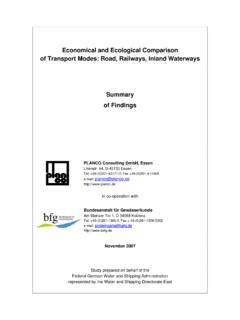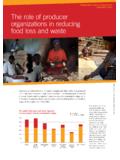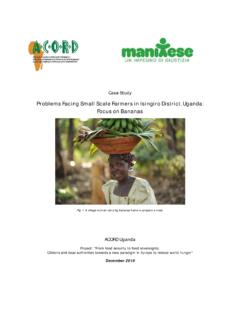Transcription of THE POWER OF INLAND NAVIGATION - Home - EBU
1 BargE unIonInlandshIppIng an outstandIng ChoICETHE POWER OF INLAND NAVIGATIONThe future of freight transportand INLAND shipping in Europe2010 - 2011 THE POWER OF INLAND NAVIGATION2 ColophonA publication ofdutch INLAND shipping Information agency (BVB)po Box 23005 3001 Ka rotterdamVasteland 12e 3011 Bl rotterdamt +31 (0)10 412 9151F +31 (0)10 433 09 cooperation withExpertise and Innovation Centre INLAND shipping (EICB) po Box 23133 3001 KC rotterdamVasteland 12e 3011 Bl Barge union (EBu)po Box 23210 3001 KE rotterdamVasteland 12e3011 Bl rotterdamt +31 (0)10 411 60 70F +31 (0)10 412 90 and layout do Company: and production platform p, rotterdamDevelopment and coordination W. Volker (BVB), M. rookConcept and text de Vries (BVB)this publication may be reproduced rights-free, with the exception of imageson pages 60-67 and provided the source is specified.
2 This publication is available for download on 4 Chapter 1. sustainable logistical processes. 5 Chapter development is a conscious choice. 15 Chapter chooses the sustainability of INLAND shipping. 31 Chapter European INLAND shipping fleet and innovations. 41 Chapter 5. Is a conscious choice for INLAND shipping also a sustainable choice? 53 Glossary 68(Inter)national INLAND Shipping Organisations 69 Post script fourth editionhalfway through 2008, large parts of the world got hit by the credit crisis, followed by a decrease in economic activity and world trade by 15 to 20 percent in the first quarter of 2009. goods transport across world seas, transhipment in maritime ports and the hinterland transport from maritime ports were as a result confronted by a sudden decrease in goods transport.
3 At the going to press of this book, the figures could not yet be processed. Most transport statistics have a processing time of more than a year. Knowledge of previous recessions has taught us that world trade and goods transport after a recession always grow fast, beyond the level before the recession. In fact goods transport after a recession always plays catch up with extra growth during years. Based on this we are confident that the future scenario s outlined in the POWER of INLAND NAVIGATION have sufficient reality value. In addition we express hope that the crisis will be in control soon and our initiatives may be able to contribute to this. producers of the POWER of INLAND NAVIGATION (april 2009)4 Foreword the shelves of an average modern supermarket carry 12 to 15 thousand different products.
4 Europe s 460 million consumers consider this a perfectly normal situation, since scarcity is not known here. this raises the question: are we in our modern society sufficiently aware of the actual processes behind the seemingly endless supply of products? and is this something which can continue? the law of economics dictates that the manufacture and transpor t of goods takes place at the lowest cost and the highest profit. however, the critical consumer increasingly demands sustainability and the guarantee that products are manufactured and transported under acceptable conditions. What can we do to contribute to these developments and meet these demands?traditionally, northwest Europe is a trade region, due to the geographic position at the coast and in the delta of large rivers. this position has contributed significantly to the economic development of the region, but also led to the processing of physically large flows of cargo, of european origin and destination, through the ports of the hamburg le havre range.
5 As a result, our resources and the environment are increasingly under pressure. this publication aims to illustrate these cargo flows and to highlight opportunities for making responsible choices and realizing sustainable also asked ourselves whether the effects on a global scale of developments like globalization, can make a positive contribution to more sustainable living conditions, the distribution of wealth or the fight against social inequality. eventually we will answer these questions affirmatively, because the positive effects of globalization are deemed greater than the negative effects. still, much remains to be done. a time of recession has definitely started, and seemingly fixed values from the past are being replaced by uncertainty. new roads must be travelled in order to control the financial markets better.
6 The crisis can also be an opportunity to re-assess our economic activities and the flows of goods which are connected to that and to examine whether there are hope this publication will contribute by offering new insights in the areas of transport and publication introduces a new view on logistics, whereby sustainable transport techniques will receive special attention. using the so-called 80/20 method, coined by professors Fransoo and Kiesm ller of tu-Eindhoven in the netherlands, the use of trucks will be reduced to a minimum and the alternatives of rail, INLAND shipping and shortsea transport will have extra room for development. logistic advisors of our European organizations are armed with the expertise necessary to adequa-tely guide enterprises in making these complex development of future scenario s is based on studies in this field which have been conducted by the royal dutch shell.
7 The POWER of INLAND NAVIGATION is a publication of the dutch INLAND shipping Information agency (BVB), in cooperation with the European Barge union (EBu) and the IVr. the publication is financially supported by the European union and also made possible by the Expertise and Innovation Centre for INLAND hhipping (EICB). We would like to thank the central Bureau of statis-tics and the IVr for making the necessary data available to de Vries director royal schutevaer/secretary Bureau Voorlichting BinnenvaartCHAPTER 1 Sustainable logistical Modern consumers put significant pressure on themselves and the environment. Our society has been structured in such a manner as to meet these high demands at the lowest possible effort and costs. And we have managed to take this very far. In fact, at any given moment of the day, in West Europe we can, if we so desire, access any product we demand.
8 And mostly these products are available at any desired quantity. Hardly ever or never do we realize the considerable and complex organization necessary to grow, manufacture or alter these products and subsequently transport them to the desired location. The process of the source of a product leading to adaptation, packaging, storage, transshipment and transport to the final destination or consumer is called the logistic chain or supply ago at school we learnt that oranges come from spain, coffee from Brazil, olive oil from Italy (or greece), and tea from Ceylon. Would an average West european consumer be aware that asparagus for example might very well come from peru these days, flatfish (plaice) or shrimps from thailand or shoes and clothes from China or Vietnam? no, more and more people think milk, hamburgers and potatoes come from a factory nearby, without realizing the actual source of these products.
9 This is partly understandable, because even though these products often have natural origins, nowadays they tend to form part of an advanced technical process. Before final products reach our stores they have travelled a long road. this publication follows the journey of these products across the scale at which some conglomerates produce indicates the involvement of a technologically advanced process. and in fact this is the case for most products which are sold, changed, packaged and sold again on a large worldwide scale by enterprises. there simply is no other system to feed every person in the western world. the advantage of this worldwide network of buying and selling goods through such a company is the guaranteed quality at a relatively low cost. Because bad quality would very quickly lead to the loss of reputation.
10 The quality and food safety of our products is therefore much better now than decades ago. the information on the product, its origin, adaptation and nutritional value, is also ever nice example of this is salmon from norway. In the past, when salmon was still caught in the wild, the salmon had to be checked for taste and quality, before being sold. From these formerly caught in the wild, generally only one in three used to be of good quality. Most salmons sold in retail now were grown (in large, round, floating swimming basins drifting on the sea), which is why they are virtually identical in taste and quality. their taste and quality in fact do not differ significantly from wild salmon, which in turn benefits from more protection in their natural habitat.



